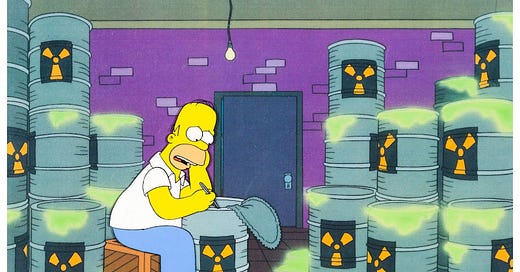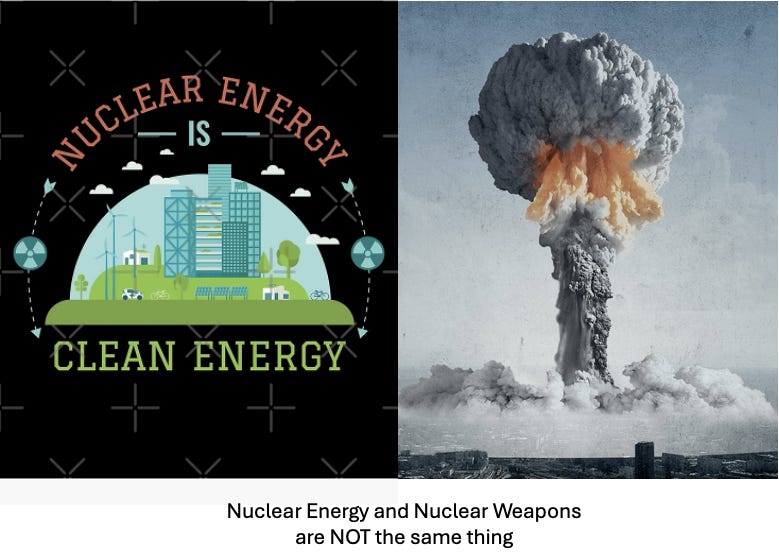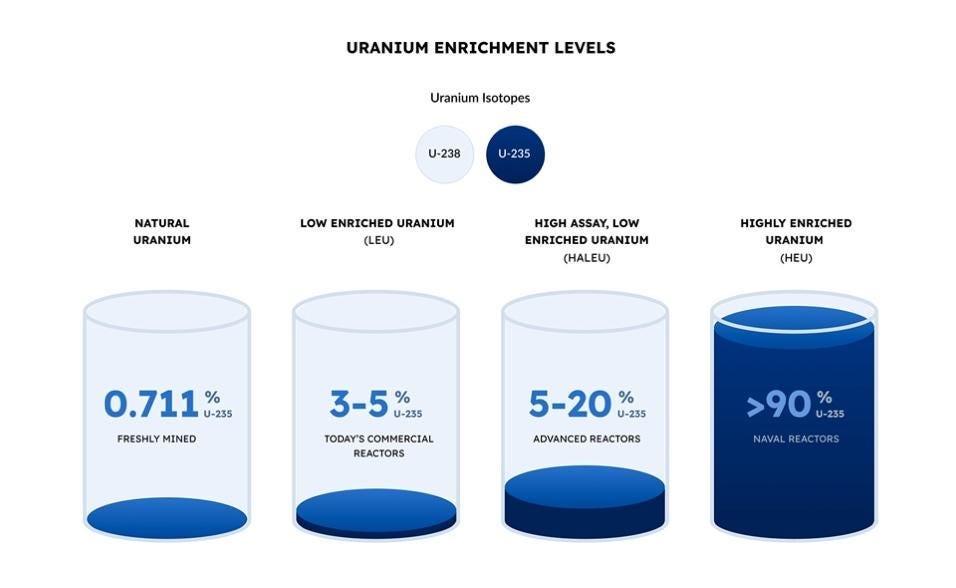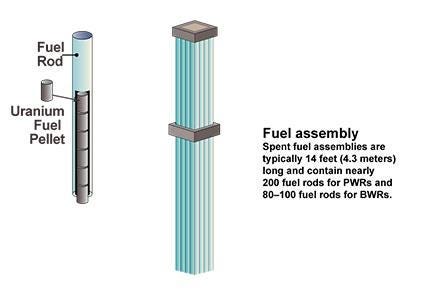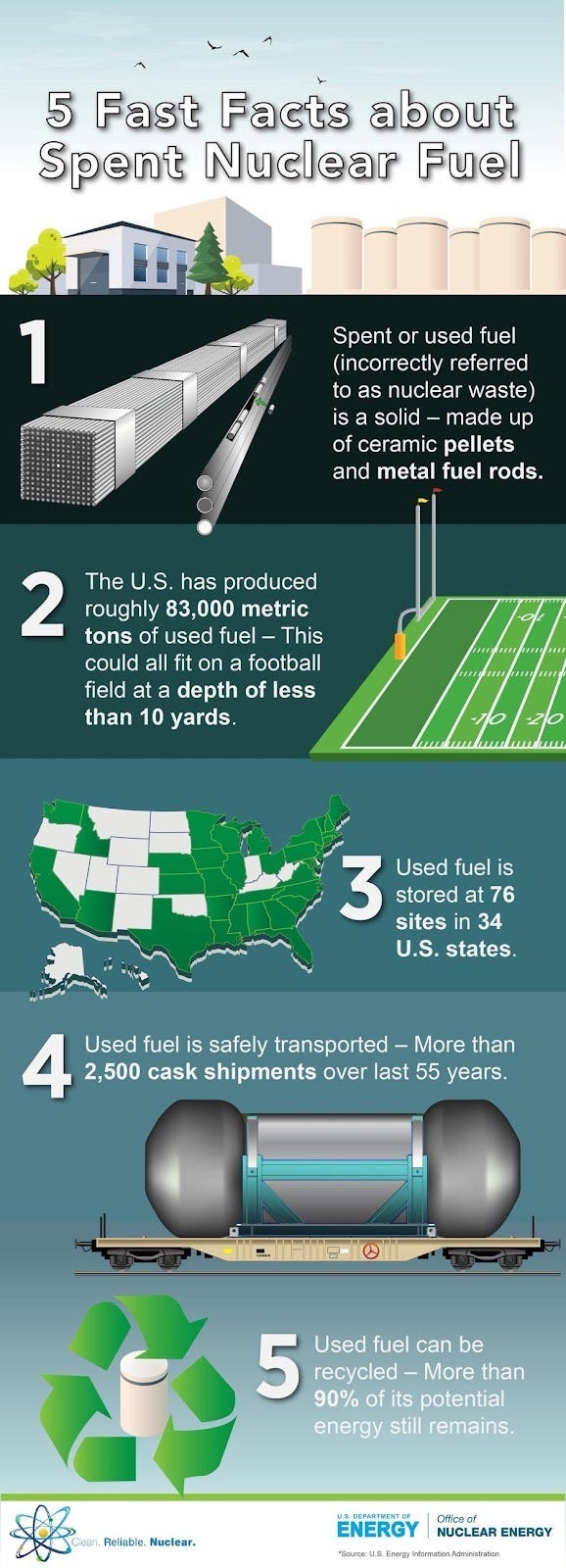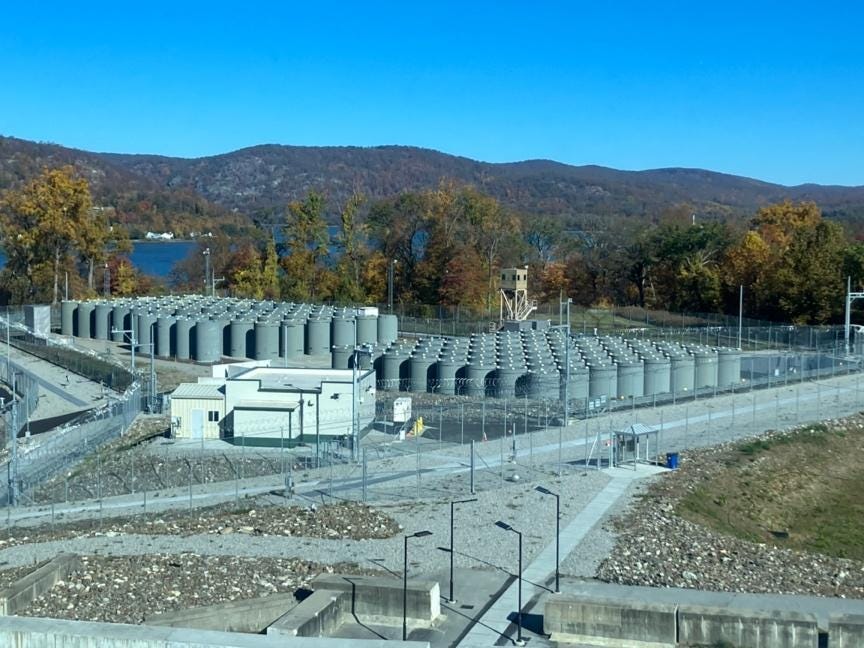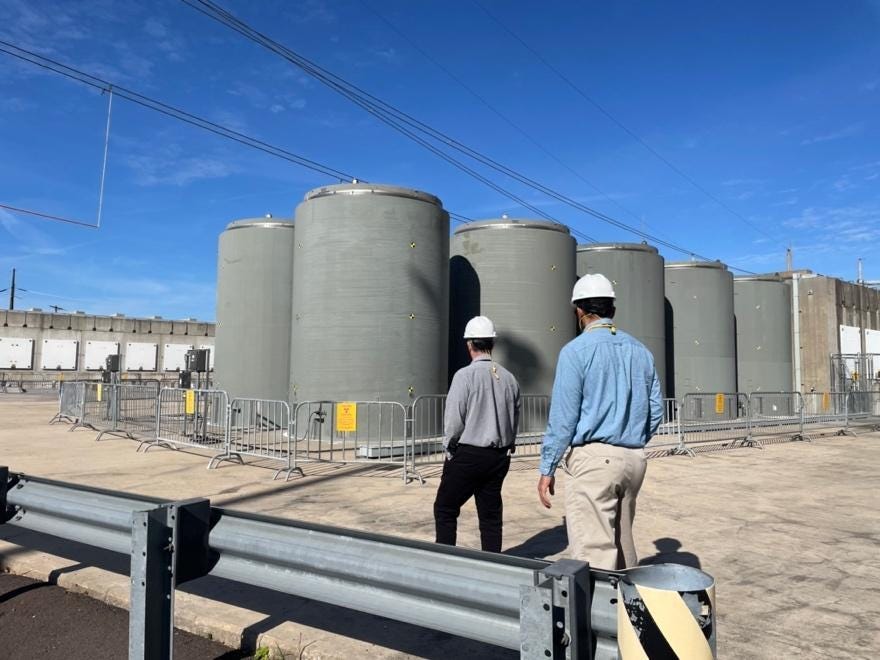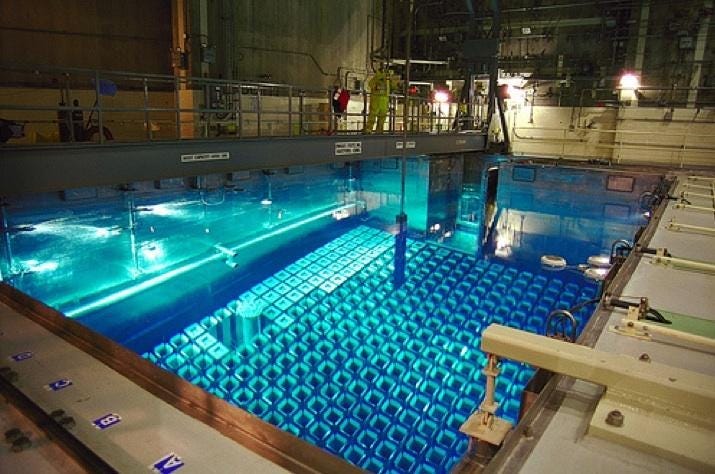While on my “Human-Powered Nuclear-Power Bike-Tour” I met a lot of fabulous people. If and when the topic of nuclear energy came up, which it did frequently, I would often be asked the question: “What about the waste?”
While this concern is valid and the topic needs to be discussed, many of these conversations seemed to start with the belief that nuclear waste is a large and unsolvable problem that has the potential to render entire areas uninhabitable for thousands of years. Another reasonable concern is the potential for negative impacts on the environment, which is a concern that is shared between all waste streams. Yet, as I study nuclear energy more, I’ve come to learn that not only is the problem of nuclear “waste solvable”, but it is essentially already solved and has been for decades. It boils down to 3 key points:
The “waste” from nuclear energy isn’t actually waste in a technical sense;
When there is waste, there is a very small amount of it, particularly in comparison to how much energy we get from it and in comparison to the wastes from other energy sources;
Nuclear waste has been managed effectively and safely in the US for the past 50 years: it has never harmed a person or the environment in any meaningful way.
Nuclear Weapons vs Nuclear Energy
One common misunderstanding I’ve noticed is the assumption that nuclear energy and nuclear weapons production are the same thing. These are two completely different activities, and so it is important to address the waste issues from each separately. Thus, the main focus of this piece will be on the waste from nuclear energy, but I will highlight a few things regarding waste from nuclear weapons production. For simplicity, when discussing wastes from nuclear energy I will use “nuclear waste” and for nuclear weapons production I will use “nuclear weapons waste”.
A Quick Overview of Nuclear Waste
Before we dive into some of the aspects of nuclear waste, let’s first establish a common understanding of what it actually is. The common visualization of nuclear waste is a glowing green “ooze” leaking out of yellow barrels, like in the Simpsons. This image has stuck in a lot of people’s minds, despite the fact that nuclear energy waste is a solid, not a liquid. Let’s look at the process of making and using the fuel for nuclear energy.
The 94 nuclear energy reactors in the United States utilize Uranium for fuel. Naturally occurring uranium is mainly composed of two different isotopes: 99.3% is Uranium-238 (U-238) and 0.7% is Uranium-235 (U-235). U-235 can be readily “fissioned”, or split, for generating energy. U-238 on the other hand, cannot be readily fissioned for energy production, but can be transformed into Plutonium-239 (P-239), which can then be fissioned for energy production (more on that later).
To manufacture the fuel, natural uranium is “enriched” so that the concentration of U-235 is increased from 0.7% up to 3–5%, or what is called “low enriched fuel”. It’s important to note that weapons-grade enrichment is considered 90% or higher. The “low enriched fuel” in a nuclear reactor is unable to explode like a nuclear weapon — the laws of physics prevent this.
After enrichment, the low enriched uranium is formed into “fuel pellets” that are about the size of a pencil eraser. To give a sense of how much energy is contained in this pencil eraser sized pellet, it is equal to approximately 1 ton of coal, 149 gallons of oil, or 17,000 cubic feet of natural gas (NEI). This single pellet could power an average American home for 2 weeks (Anker, 2024). That’s a lot of energy packed into a small space!
These pellets are stacked into “fuel rods” that are then assembled into “fuel assemblies”. According to the World Nuclear Association “An 1100 MWe PWR core may contain 193 fuel assemblies composed of over 50,000 fuel rods and some 18 million fuel pellets” (WNA, 2021). These fuel assemblies are what is loaded into a reactor, where a controlled nuclear fission reaction is initiated to generate heat, which is then used to generate electricity.
Depending on how often a nuclear power plant has a “fuel outage”, the fuel assemblies will be generating emission-free energy continuously for 4.5–6 years before they are removed. These removed fuel assemblies are what people refer to as “nuclear waste”. It is in a solid form, unlike the depiction of nuclear waste in the Simpsons.
1) Nuclear “Waste” Isn’t Actually Waste
A quick Wikipedia definition of waste is “any substance discarded after primary use, or is worthless, defective and of no use.” By this definition, one would assume that nuclear waste has no use once it is taken out of a reactor. We will look at why this description is not accurate.
According to the US Department of Energy, after fuel assemblies are removed “more than 90% of its potential energy still remains in the fuel, even after five years of operation in a reactor” (DoE, 2022). If we take this at face value, we could get 50 years of emission-free energy out of nuclear fuel. But, unfortunately, it’s not that simple. To get the remaining energy, there are two main pathways: fuel reprocessing and fuel breeding.
Through “fuel reprocessing” we can get 25–30% more of the remaining energy, which reduces the volume of waste by about 85% (WNA, 2022). Essentially, this process separates the usable fuel from the actual wastes. The reprocessed fuel can then be reused in a reactor. This process comes with various costs and concerns, but it is possible, and France currently gets about 17% of their electricity from reprocessed fuel (WNA, 2024).
To access the remaining energy, we can “breed” the fuel. Remember when I mentioned that U-238 was not readily usable but could be transformed into P-239 which can produce energy? A breeder reactor does exactly that, it “breeds” U-238 into P-239. Because there is much more U-238 in the world than U-235, there is a large potential for accessing substantially more energy through this technology. Back in 1953, the United States proved this concept with the “Experimental Breeder Reactor-I” or EBR-I (INL). Interestingly, this nuclear reactor was the first to generate electricity in the world. So, as was said in “The Six Million Dollar Man” television series: “We have the technology.”
Now that we know there is 90% more energy left in the nuclear “waste”, we see that it really isn’t “waste”: A more accurate term is “partially used fuel”.
2) There is a Very Small Amount of “Partially Used Fuel”
Let’s say you’re still not convinced. Even if nuclear “waste” technically isn’t a waste, it still poses issues because it is radioactive and needs to be managed effectively. So, let’s look at how much nuclear “waste” is generated and compare this with other energy sources. Because of how energy dense nuclear fuel is, we can get a lot of energy out of a small amount of fuel. The energy density of nuclear fuel is truly its superpower: “The energy from the nuclear fission of uranium-235 is more than two million times denser than any fossil or biomass fuel” (Cutler, 2024).
At a national level, nuclear energy currently produces about 20% of the entire country’s electricity. And the “waste”? Well, “U.S. commercial reactors have generated about 83,000 metric tons of spent fuel since the 1950s. If all of the waste were able to be stacked together, it could fit on a single football field at a depth of less than 10 yards” (DoE, 2022). In comparison, “a single coal plant generates as much waste by volume in one hour as nuclear power has during its entire history” (Hickman, 2019).
Along my trip, I toured 7 different nuclear power plants, and as I will discuss later, all of their “partially used fuel” is stored on site. The nuclear industry is unique in that it is one of the few (maybe the only?) industries that can actually say it accounts for its waste. To give a better idea of how little “partially used fuel” is made to generate massive amounts of electricity, let’s look at a few of the plants I toured:
Indian Point Energy Center — Buchanan, New York
Generated enough emission-free electricity to power ~25% of New York City for 50 years.
All of the “partially used fuel” is sitting on site in these concrete and steel canisters.
Limerick Generating Station — Limerick Township, Pennsylvania
Generated enough emission-free electricity to essentially power Philadelphia for 40 years.
Again, all of the “partially used fuel” is sitting on site in these concrete and steel canisters.
So, as we can see, when we take into account how much emission-free energy we get from nuclear fuel, the amount of “partially used fuel” we end up with is actually very small. In comparison to how much waste the dirtiest energy source (coal) makes, it is a sliver of a percentage point. The energy density of nuclear fuel is truly incredible.
3) It is Already Managed Effectively and Safely in the US
But, as you might know, the United States does not currently reprocess or breed nuclear fuel. Because of this, we do need to manage the “partially used fuel” to ensure it does not harm humans or the environment.
When a fuel assembly comes out of a reactor after 4.5–6 years, it is incredibly radioactive. Without shielding or mitigation, it would kill someone if they were within a few feet of it. However, before anyone panics, remember that even something like flying in airplanes can be incredibly dangerous if something were to go wrong. In response, we have engineered solutions around it, making air travel safer than personal vehicle travel. Management of “partially used fuel” has been engineered so that it makes a dangerous thing very safe.
“In over 50 years of civil nuclear power experience, the management and disposal of civil nuclear waste has not caused any serious health or environmental problems, nor posed any real risk to the general public” (WNA, 2022).
Immediately after removal, “partially used fuel” is stored in a large pool of water called a “spent fuel pool”. The water does two things: (1) it cools the fuel assemblies and (2) it shields the radiation. According to the Nuclear Regulatory Commission, storage of freshly removed fuel assemblies in 20 feet of water provides adequate radiation shielding for anyone nearby the pool (NRC, 2020). It will stay here for about 5 years, despite 87% of the radiation decaying off within the 1st month (Hickman, 2019). A small portion of the “partially used fuel” in the US is currently in this type of storage.
After time in the “spent fuel pool”, the “partially used fuel” will then be put inside a steel and concrete “dry cask”. The steel and concrete effectively shields the remaining radiation. Since most of the radiation has decayed by this point, they can also be air cooled to prevent excess heat buildup. 40–50 years after the initial removal, over 99% of the radiation and heat will have decayed (WNA, 2022). Almost all of the “partially used fuel” in the United States is currently stored in dry casks.
To give an idea of how strong and resilient these casks are, check out this video to see testing that was done on them. Skip to 1:00 to see a ground collision test, and 1:40 to see a train collision test. Summary: they are nearly indestructible. We have taken a dangerous thing and engineered solutions to make it safe. This is the power of human ingenuity.
Nuclear Energy vs Nuclear Weapons Production
We’ve already discussed nuclear energy “waste” in detail, so let’s discuss wastes from nuclear weapons production for context. Again, it is important to differentiate nuclear energy from nuclear weapons.
Both gasoline and napalm are derived from the same product and use the same type of energy (chemical). Would you stop using gasoline in your car simply because napalm has been used in war? I’d imagine (read: hope) most rational people would respond with “No, that’s ridiculous. They are similar, but totally different” and this is exactly my point.
I won’t go into too much detail, but there have been three major nuclear weapons production sites that have had controversy around their operations and cleanup: Rocky Flats in CO, the Savannah River Site in South Carolina, and the Hanford Site in Washington.
Rocky Flats — 15 miles Northwest of Denver, CO
Rocky flats served as the main site for the manufacture of nuclear warhead triggers, like plutonium cores. Radioactive contamination of the surrounding area resulted from two major plutonium fires in 1957 and 1969. In June of 1989, FBI and US EPA agents “raided” the facility due to the environmental crimes and operations were halted in December of the same year. In October 2005, the 10-year cleanup effort was completed and it was renamed the “Rocky Flats Environmental Technology Site”. While the “Peripheral Operable Unit” area is now a National Wildlife Refuge, the “Central Operable Unit” is not approved for unlimited use and is reassessed every 5 years to ensure safety to the surrounding areas (DOE, 2024).
Savannah River Site — 25 miles Southeast of Augusta, Georgia
The Savannah River Site produced mainly tritium and plutonium for nuclear weapons. It is currently not operational and since 1981 an environmental remediation project has been ongoing at the site. “Site remediation continues at Savannah River Site with more than 78 percent of the 515 total number of waste units completed, and over 25 percent of 1,126 total number of excess facilities safely dispositioned to date” (DOE).
Hanford Site — 30 miles northwest of the Tri-Cities area in Eastern Washington
The Hanford site was created in 1943 as part of the “Manhattan Project” to produce plutonium. Today, waste management and environmental cleanup are the primary missions. Pulled from Wikipedia: “Many early safety procedures and waste disposal practices were inadequate, resulting in the release of significant amounts of radioactive materials into the air and the Columbia River, resulting in higher rates of cancer in the surrounding area. The Hanford Site became the focus of the nation’s largest environmental cleanup.” This site has had a lot of controversy over its past operations and the cleanup efforts are ongoing and costly. As of 2023, there still remain areas of groundwater that are contaminated above federal regulations.
While the production of nuclear weapons materials and the ensuing controversies over environmental contamination were not the purview of this piece, I believe it is important to be up front and acknowledge them, while understanding that they are completely separate from the nuclear energy industry and how they operate. The production of nuclear weapons does not have a great track record, and when this is conflated with the nuclear energy industry, it is no wonder that most people believe nuclear energy waste to be such an issue. I hope that you will now understand the difference and understand that they are not the same.
So, What is the “Solution”?
After reading through this, I hope that you have a better understanding of what “waste” from nuclear energy is and some of the facts surrounding it. To recap:
The “waste” still has 90% of the energy remaining in it;
There is a very little amount of it, particularly given much energy it produces;
It is already managed effectively and hasn’t harmed any person or environment;
“Waste” from nuclear energy and nuclear weapons production are two different things.
Overall, I think we need to have an honest conversation about what the potential “problems” are:
If the problem is making sure that the “waste” doesn’t cause harm to humans or the environment, we should then also hold other energy generation sources to the same standard. By this philosophy, all wastes should be treated with the same requirements, not just nuclear energy. If this is our standard, wastes from nuclear energy have not resulted in real harm to humans or the environment in its 50 years of energy generation.
If the problem comes from confusing the environmental consequences of nuclear weapons production with nuclear energy, then we should rightfully attribute the consequences to the source. By conflating the past mistakes of nuclear weapons production with nuclear energy, we risk demonizing one of our best tools for mitigating climate change.
By actually looking at the problems around nuclear waste, we see that we really have already solved them and there is really no reason to bury it deep underground, or heaven forbid, shoot it into space. We are making the nuclear waste issue bigger and more expensive than it needs to be. These complications are only getting in the way of utilizing our best tool for lowering emissions and providing society with reliable electricity. The sooner we realize this, the sooner we will understand that nuclear energy is our best bet at mitigating climate and sooner we can get to work building more of it!
Sources:
Nuclear Energy Institute (n.d.). Nuclear Fuel. https://www.nei.org/fundamentals/nuclear-fuel
Anker Solix (November 11th, 2024). Electricity Usage: How Much Energy Does An Average House Use in America. https://www.anker.com/blogs/home-power-backup/electricity-usage-how-much-energy-does-an-average-house-use
World Nuclear Association (October 13th, 2021). Nuclear fuel cycle. Nuclear Fuel and its Fabrication. https://world-nuclear.org/information-library/nuclear-fuel-cycle/conversion-enrichment-and-fabrication/fuel-fabrication
Department of Energy (October 3rd, 2022). Office of Nuclear Energy. 5 Fast Facts about Spent Nuclear Fuel. https://www.energy.gov/ne/articles/5-fast-facts-about-spent-nuclear-fuel
World Nuclear Association (January 25th, 2022). Nuclear Fuel Cycle. Radioactive Waste Management. https://world-nuclear.org/information-library/nuclear-fuel-cycle/nuclear-waste/radioactive-waste-management#:~:text=Storage%20involves%20maintaining%20the%20waste,after%20about%2040%2D50%20years.
World Nuclear Association (May 11th, 2024). Nuclear Power in France. https://world-nuclear.org/information-library/country-profiles/countries-a-f/france
Idaho National Laboratory (n.d.). Experimental Breeder Reactor-I. https://inl.gov/ebr/#:~:text=On%20December%2020%2C%201951%2C%20EBR,produce%20electricity%20using%20atomic%20energy.&text=In%201953%2C%20testing%20at%20EBR,last%20time%20in%20December%201963.
Cutler Cleveland (May 9th, 2024). Fuel energy density: What is it and why is it important? https://visualizingenergy.org/fuel-energy-density-what-is-it-and-why-is-it-important/
Nuclear Regulatory Commission (July 8th, 2020). Spent Fuel Pools. https://www.nrc.gov/waste/spent-fuel-storage/pools.html
Hannah Hickman (November 19th, 2019). Nuclear Energy Institute. What Happens to Nuclear Waste in the U.S.? https://www.nei.org/news/2019/what-happens-nuclear-waste-us
Department of Energy (November 2024). Department of Energy. Rocky Flats Site, Fact Sheet. https://www.energy.gov/lm/articles/rocky-flats-site-colorado-fact-sheet
Department of Energy (n.d.). Facts from the Savannah River Site. https://www.energy.gov/sites/prod/files/2019/02/f60/SRS-Overview-Facts.pdf
Department of Energy (January 2024). Hanford Cleanup Overview. https://www.hanford.gov/files.cfm/Hanford_Cleanup_Overview_Fact_Sheet.pdf

